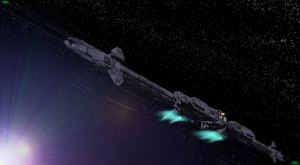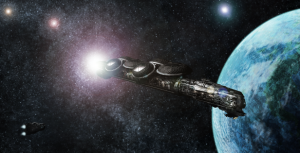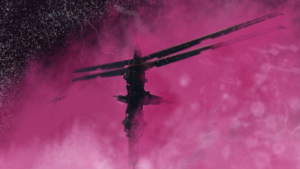Scarabs: различия между версиями
>BoryaTheSlayer (Added Jotunheimr :)) |
>Kyres1 (Total history rewrite) |
||
| Строка 41: | Строка 41: | ||
==History== | ==History== | ||
Scarab origins date back to the departure of what would become the Core Fleets in 2205, massive residential and combat Warp vessels built on the fastest drives of the time. Utilizing only the most cutting edge agricultural and scientific technology, the African Confederation started the Children of Earth’s Pioneering Fleet. This would be known as the CEF, promising millions a new home some three-hundred light years away in a newly purchased territory. Within, multiple barren planets which could see simple terraforming to accommodate the burden of life. The destination, known as Trappist to the public, would soon find itself plastered on commercial advertising globally spanning Earth. Quickly did Trappist become a grand figure to hopeful pioneers, and roughly 250,000 people set out in the CEF with some three million others in trailing fleets. | |||
Charmed by promises of the great unknown, | Charmed by the promises of the great unknown, the CEF propped itself up as being a “new hope for a galactic Humanity,” then only paralleled by the likes of the Martian terraforming projects. While Zeng-Hu Pharmaceuticals pioneered the terraforming of the inner solar system, Einstein Engines promised a safe home far away with little of the difficulty seen changing Mars’ environment. The three million soon doubled, then quadrupled as, over the course of thirty-five years leading to 2240. The CEF took on newer, faster vessels as Warp technology advanced and more joined the Core Fleets. The overwhelming majority of these ships would be powered by the efforts of Einstein Engines, having been assured to be without fault. | ||
The | The struggle that would then come was apparent immediately, as in 2243, the vessels had in accordance with Einstein Engines’ energy-saving solution, unified their sensor data into one singular ship’s computer. In essence, the Fleet’s travel from then on rested on the shoulders of a singular ship, a capital vessel known as the Mansa. Around this vessel, the entire fleet no matter how fast or slow must have followed. This spelled disaster, as one simple malfunction had placed the fleet in uncontrolled Warp for months - beginning the Lost Years, a time of great strife for the Core Fleets. Now sent wildly off course and out of position, there was no feasible way to resume the original mission. | ||
In the Lost Years, all contact with the outside world - and any hope of return to Earth - was lost. Those responsible for the malfunction were killed, and the fleets dissolved into uncontrolled chaos for some nondescript period of time, for exactly how long, none can tell. From the chaos, a simple man being the great-grandson of a mere bookkeeper arose on board the Mansa. His name was Apollo Kagwa, and from a relative bastion of peace amidst the fleet, he studied greatly into literature and media of old. With a wealth of knowledge at his disposal and a vision for the fleet’s survival, he gathered like-minded individuals and overtook the command hierarchy of the Mansa in a bloody war for unification - one that would become known as the Holy War, the Jihad that secured the survival of the Scarabs. | |||
During these times their religion shifted and changed, turning into what is now known as Stutuism. Preaching that scarcity is the greatest enemy, that peace and strength is achieved through unity and domination. Not only physical, but also mental and spiritual. It also established who should do what and that each man and woman has their life course set for them, even if they might not know it. They worship a single god and consider every living human an extension of said deity, saying that scarcity and evil exists only to make children into adults, and unwise into the wise. He preached of Earth and its many bounties, and the people listened, knowing well what they could gain from going back to their old human lifestyles. Eventually, after many phases, Kagwa had conquered the Core Fleets as a whole with legendary strength and boundless wit. | |||
The Tian Kehan (an honorary title, vaguely Khan of Heaven) named Iraiya, the fourth successor of Kagwa is the current “leader” of the unified Scarabs. Today from their throne on the new capital ship King’s Omen, they seek out to unify Humanity - at least those like her own - under a single banner no matter the costs. Among Scarabs, she is known as the Queen in Blue. Scarabs represent an alien form of Man left to itself for nearly two hundred years, different and distanced from all societal progression that influenced their hand otherwise. In 2438, Scarabs made their grand return to the Alliance territories, and through trade upgraded their entire home fleet with bluespace technology. Now, the fleet is a combination of the inefficient past and sleek present. Much of this was obtained through the Techno-Conglomerate, who they maintain excellent relations with. | |||
The Tian Kehan (an honorary title, vaguely Khan of Heaven) named Iraiya, the fourth successor of Kagwa is the current “leader” of the unified Scarabs. Today, they seek out to unify Humanity - at least those like her own - under a single banner no matter the costs. Among Scarabs, she is known as the Queen in Blue. Scarabs represent an alien form of Man left to itself for nearly two hundred years, | |||
=The Fleet= | =The Fleet= | ||
Версия от 07:29, 19 декабря 2019

The largest representation of offworlders, the Scarabs perfectly embody the nomadic characterization most of the zero-G-bound Humans have founded over the years. They are a clever bunch, numbering in the millions yet supporting themselves by utilizing advanced compact hydroponics and insect farming to survive and compete in the modern world.
Originating from African Confederation colonists in the early 2200’s, their remarkable history demonstrates the true flexibility and resolve of Humanity. These pioneers, in their early years, banded together with those of other nations launching numerous vessels at similar times for the collective goal of colonizing the depths of space.
Although they’re united, Scarabs still stick to naming their children after the colony ship they inhabit.
Culture
Scarabs adopt many of the often seen traits of other Offworlders, with a deep conversationalist attitude ingrained in all Scarabs out of necessity. The Scarabs have known centuries of scarcity, and it affects their culture and mindset very heavily. Greed, laziness and wastefulness are considered the most condemnable misdeeds and most vile insults, whereas selflessness, resourcefulness and hard work are the most praisable virtues.
Tujmansaal
Tujmansaal is a very common spiritual concept that most Scarabs can deeply connect with. Roughly translated as “blissful times”, it represents a state in which a person can easily satisfy any of their own needs. Such a state is a very common life goal for most - simply living the rest of one’s life fed, safe and comfortable. Although one could see this as egotistical, needs of a Scarab often include being among friends and family, and seeing them happy - meaning that tujmansaal is not achievable unless all of your loved ones achieve it together with you.
Aiseheer
Aiseheer is a relationship concept used often among Scarabs, roughly translated to “brothers in need”, and meaning people working towards a common goal despite all of their differences and disagreements. A single member involved in this kind of relationship is called an aiseh (plural aiseh). After the goal in question has been achieved, the aiseh may strengthen their bond and become close, or go separate ways once more. Skrell often find this similar to their concept of qu’pluux, but with the difference of aiseheer potentially involving many people, or entire groups.
Superstition and Conservation
A very strong element of Scarab culture is superstition. Almost any Scarab is superstitious to at least some degree. Different omens, big and small, ominous and promising, vary from ship to ship, but are present everywhere. A few are universal. For example, the corpses of fellow crew must always be spaced - no space or resources should be wasted to preserve it, but neither may it be recycled or used in any form, as resorting to using fellow crew members’ dead bodies means that bad times have come, and it’s likely that it’s going to only get worse from there…
Asking for more food than you were initially given at a meal, even when available, is a bad omen commonly associated with egoism and narcissism. Instead, uneaten food and leftovers must always be preserved and used as an ingredient in the next meal that is going to be made. On station, this would mean that food left after transfer should be stored safely in a refrigerator or a heater.
Scarab engineering and maintenance crew members would often carry a spare wrench on themselves, which is a common good luck charm. However, having to give it away to someone else may spell disaster for both people in question.
Meal times are strictly and sparingly scheduled for the entire ship, and are quiet times of appreciation for the work going into producing the food. Speaking up is strictly prohibited, and making eye contact is considered to be a bad omen - instead, this is a time to recall and reflect. Afterwards, a break is to be had, as a relatively recent custom. During this break time, ships may often dock to each other, exchanging news, resources, and oral tradition.
Fiction
Fictional literature is almost non-existent due to consoles and paper being used extremely sparingly. Instead, verbal arts are almost exclusively oral, with stories, myths and legends being shared among departments or families after meal times, or passed by from ship to ship when docking.
Most common are two genres. Shiwuniket is the older one - grim and dark stories that serve as some kind of warning or precaution. Themes of death, collapse and mysterious omens are all very common. Nitaniket, more recent and less popular, is comprised of stories of overcoming and triumph, where the main characters are savvy and clever individuals who are able to make the most of the limited resources they have, using them in creative ways to deal with danger or challenges thrown their way.
Shaitan
A common character in Scarab folklore is Shaitan, the Adversary - a malevolent spirit which is said to be the personification of all evil. Although exact details differ from ship to ship, it commonly takes the form of a mysterious and elusive traveler with their eyes brightly shining, who then convinces someone to lead the entire ship to ruin. The exact details of how this is done may differ, but generally, the victim captures the light of the traveler’s eyes, becoming blinded with their own reflection and giving in to madness, now only obsessed with their own well-being, and eventually bringing the ship to a collapse.
Ceremonial weaponry
Weapons and weapon-making are almost glorified in Scarab societies, often considered extremely prized possessions. An almost universal marriage rite is presenting a beautiful, ornate knife or dagger to the significant other, who will then return it with the handle going forward if the offer is accepted, and the blade going forward if it is denied. Some ships use a decorated gun instead of a knife, but the process is generally the same, going without much fanfare. When dealing with non-Scarabs, a Scarab would often ask to sit down at a table, and then lay their weapons on it. This ceremonial disarming is not only done to take caution, but also to look at how well-made the weaponry of the other person is.
Scarabs value a good weapon and displays of power, but nothing is more wasteful than ending the life of a worker. Thus, many Scarabs enjoy bouts with fellow crew, but, taking extreme care to not hurt anyone (since it would prevent them from working for some time), don’t use their weapons in these fights, and take care not to hit the opponent too hard. As an alternative, intellectual games such as chess and checkers are often played to display intellectual prowess.
History
Scarab origins date back to the departure of what would become the Core Fleets in 2205, massive residential and combat Warp vessels built on the fastest drives of the time. Utilizing only the most cutting edge agricultural and scientific technology, the African Confederation started the Children of Earth’s Pioneering Fleet. This would be known as the CEF, promising millions a new home some three-hundred light years away in a newly purchased territory. Within, multiple barren planets which could see simple terraforming to accommodate the burden of life. The destination, known as Trappist to the public, would soon find itself plastered on commercial advertising globally spanning Earth. Quickly did Trappist become a grand figure to hopeful pioneers, and roughly 250,000 people set out in the CEF with some three million others in trailing fleets.
Charmed by the promises of the great unknown, the CEF propped itself up as being a “new hope for a galactic Humanity,” then only paralleled by the likes of the Martian terraforming projects. While Zeng-Hu Pharmaceuticals pioneered the terraforming of the inner solar system, Einstein Engines promised a safe home far away with little of the difficulty seen changing Mars’ environment. The three million soon doubled, then quadrupled as, over the course of thirty-five years leading to 2240. The CEF took on newer, faster vessels as Warp technology advanced and more joined the Core Fleets. The overwhelming majority of these ships would be powered by the efforts of Einstein Engines, having been assured to be without fault.
The struggle that would then come was apparent immediately, as in 2243, the vessels had in accordance with Einstein Engines’ energy-saving solution, unified their sensor data into one singular ship’s computer. In essence, the Fleet’s travel from then on rested on the shoulders of a singular ship, a capital vessel known as the Mansa. Around this vessel, the entire fleet no matter how fast or slow must have followed. This spelled disaster, as one simple malfunction had placed the fleet in uncontrolled Warp for months - beginning the Lost Years, a time of great strife for the Core Fleets. Now sent wildly off course and out of position, there was no feasible way to resume the original mission.
In the Lost Years, all contact with the outside world - and any hope of return to Earth - was lost. Those responsible for the malfunction were killed, and the fleets dissolved into uncontrolled chaos for some nondescript period of time, for exactly how long, none can tell. From the chaos, a simple man being the great-grandson of a mere bookkeeper arose on board the Mansa. His name was Apollo Kagwa, and from a relative bastion of peace amidst the fleet, he studied greatly into literature and media of old. With a wealth of knowledge at his disposal and a vision for the fleet’s survival, he gathered like-minded individuals and overtook the command hierarchy of the Mansa in a bloody war for unification - one that would become known as the Holy War, the Jihad that secured the survival of the Scarabs. During these times their religion shifted and changed, turning into what is now known as Stutuism. Preaching that scarcity is the greatest enemy, that peace and strength is achieved through unity and domination. Not only physical, but also mental and spiritual. It also established who should do what and that each man and woman has their life course set for them, even if they might not know it. They worship a single god and consider every living human an extension of said deity, saying that scarcity and evil exists only to make children into adults, and unwise into the wise. He preached of Earth and its many bounties, and the people listened, knowing well what they could gain from going back to their old human lifestyles. Eventually, after many phases, Kagwa had conquered the Core Fleets as a whole with legendary strength and boundless wit.
The Tian Kehan (an honorary title, vaguely Khan of Heaven) named Iraiya, the fourth successor of Kagwa is the current “leader” of the unified Scarabs. Today from their throne on the new capital ship King’s Omen, they seek out to unify Humanity - at least those like her own - under a single banner no matter the costs. Among Scarabs, she is known as the Queen in Blue. Scarabs represent an alien form of Man left to itself for nearly two hundred years, different and distanced from all societal progression that influenced their hand otherwise. In 2438, Scarabs made their grand return to the Alliance territories, and through trade upgraded their entire home fleet with bluespace technology. Now, the fleet is a combination of the inefficient past and sleek present. Much of this was obtained through the Techno-Conglomerate, who they maintain excellent relations with.
The Fleet
The Scarab’s home fleet consists of nearly 630 permanent resident vessels with more than 20,000 individuals on board each. A nondescript number of smaller vessels exist, many of which are not permanent residents and simply move with the fleet for safety or business. Here are a few examples of vessels seen in the group.
Mayfly

A ship originated from the Falklands. Colonists from this ship stick to the colors of blue, white and red. They’re primarily caucasian, this ship is known for some of the best engineers and sailors.
An oddity in design, the Mayfly was a failed prototype purchased by Einstein Engines a year after its construction in 2201. The vessel itself was meant to be a garbage swoop originally, mopping Earth’s orbit of its dangerous hyper-accelerated debris. Competitors from Einstein were one step ahead however, and upon purchasing the vessel, it was converted into a heavy-duty freighter. At 1105 meters in width, the vessel resembles a very long, sideways stick with engines strapped on and cargo departments dangling from beneath. Now, almost 50,000 people call it home.
Impukane
A Central African originating ship, the Impukane is known for its cooking and strong security force. The Scarabs from these ships would prefer colors like green, orange and red. People from these ships are primarily Central African.
A largely untouched warp battleship at nearly 730 meters long, the Impukane is one of the largest vessels in the Scarab home fleet. Its intimidating, spikey mass may look dangerous at first glance, but the ship has over time become nothing more than a garrison for much of the official defense force the Scarabs may have. It routinely deploys assistance to fellow vessels for a myriad of reasons and holds a substantial prison wing that contains almost the entirety of the fleet’s own criminals. Its population has plummeted in recent years, now around 65,000.
Fa’Ta-Bs
(Faladay Tadhhab Bsre) is a ship contributed by the Levant. They’re known for their excellent medical practitioners. Their official colors are white, blue and black. People from this ship are usually of Arabic or Jewish descent.
Built with parts sent to space from the largest coil gun ever created, the Fa’Ta-Bs is a marvel of engineering from the 2200’s. The ship itself is relatively small in terms of the fleet, with a population of 11,300, but it also carries the fleet’s foremost medical supplies and response equipment. There are few children if at all kept on board the ship itself, with those on board explicitly being workers for the fleet.
Su-Yeongseon
The Su-Yeongseon is a vessel with roots from eastern Asian, namely Korean descent who had branched off from an international effort to colonize the Antarctic in the early 2200’s. They are well known for their atmospheric manipulation and engineering prowess.
From the newly-founded city designated Sierra Peak, the world’s largest Antarctic colony sprouted an effort to redirect the incredibly advanced environment control and habitation techniques into space. This was seen as a massive success to the Scarabs later down the line, with many of the tricks seen in surviving the harsh tundras now being used to preserve lives on board Scarab vessels. The forefront of this advanced study is the Su-Yeongseon, a large warp cruiser, built in 2197 and now retrofitted for bluespace travel that originally departed with the fleet for defensive purposes. Over time it was converted into an engineering warehouse, with many of its drone bays and missile silos now serving as hangars and storage compartments. The ship itself was built to hold 22,000 people at maximum, but over time has grown to have a population of 42,000 or more with space to spare thanks to modification.

San-Khöl
(Sansryn Khölög) is a Mongolian originating ship. Colonists from this ship primarily enjoy the colors of red, blue, and yellow. They are known for their gardeners, hydroponicists, and scientists. People from this ship are usually of Mongolian or Chinese descent. Built over the course of five years in Ulaanbaatar, the 1100 meter long San-Khöl is an impressive hydroponics vessel. Although capable of holding roughly 25,000 passengers, most of the available space on-board is dedicated to storage of water, food processing, and most importantly the eight hydroponics domes installed onto the ship’s exterior. These are used for fruits, vegetables, and most importantly insects. Three varieties of insect are the most raised here, the Hakhma, a massive beetle the size of a small car. These are utilized for their feed to meat ratio and friendly disposition. Secondly, the Süüs, a variety of honeypot ant that are soda-can sized. These are typically fed cactus juice, which the ant processes into an edible, reportedly tasty and highly nutritious juice, often seen hanging from a Scarab’s belt. Lastly various species of spider, used for their high-strength silk. The ninth dome is entirely devoid of such hydroponics, being used primarily for theatre and entertainment.
Bilröst, Jörmungandr and Jötunheimr


The CCV Bilröst and Jörmungandr are two ships contributed by the former Scandinavian Coalition. This group was formed around the year 2015 in response to the collapse of the European Union. The countries of Denmark, Norway, and Sweden hastily turned to each other for stability, reforming a modern version of the Scandinavian Monetary Union. Eventually the Bilröst was constructed in the year 2129, and the Jötunheimr in 2130. However, the plan was malformed. Certain aspects of the ship were under-engineered, certain systems were lacking in redundancies and backups, and an overall lack of strategy regarding reaching the promised land the Confederation had purchased. The addition of the escort ship, Jörmungandr, only complicated affairs, and not long after their launch, the Scandinavian Coalition was in the red.
With so much of the Coalition’s focus on the new space faring vessels, its people fell to the wayside. Citizens of the Coalition faced food shortages, lack of available healthcare, and an increasing difficulty in finding good work. Times were dark, and with such unpleasant circumstances, there was one thing humans historically turned to - religion.
And it was thus that the people of the Coalition started to look to their old ways.
The people of the Coalition filled themselves with forgotten gods and culture, and it was thanks to this that they gained the strength that they needed to see themselves through adversity. They persevered, worked with what they had, and created the means aboard their new ships to end hunger and heal the sick - and it was in this way that they grew in purpose.
Bilröst
The CRV Bilröst (Bifröst) was the first ship constructed by the Scandinavian coalition. Named after the burning rainbow bridge connecting Midgard and Asgard, the most important activities performed aboard the Bilröst are of the scientific variety, as well as medical work being split between here and the Jörmungandr. Here, important research is performed to enhance the Offworlder quality of living; musculoskeletal and immune system supplements, different types of bracing equipment, and even the first ESS prototype have undergone development here. Lastly, branching off chemical-based tomfoolery in the early days, the Bilröst is known across the flotilla for their excellent skills in making various confectionery products, especially candy and chewing gum.
Jörmungandr
The CEV Jörmungandr is a satellite of sorts that accompanies the Bilröst. Named after the Midgard Serpent surrounding the Earth, it is significantly smaller in size, and is only used for non-civilian purposes. The main function of Jörmungandr is to handle and observe security scans to protect the main vessel. Access to the Jörmungandr is normally restricted to capable operators. Typically personnel here are either of an investigative nature, the temporary holding of criminals, or the maintenance and operation of various drones and robots, combat or otherwise. The Jörmungandr also keeps a small retinue of medical staff freely available to all Scarabs.
Jötunheimr
The CCV Jötunheimr (Jotunheim) was the last ship constructed by the Scandinavian coalition, and the largest of the three, the ‘center of life’ for them, and holds the highest population; owing to possessing the most residential space. Named after the ancestral homeland of the Jötnar, typical work aboard the Jötunheimr is the everyday logistics, mineral recovery, salvage, beekeeping, hydroponics and service/cooking that keeps the flotilla going. The Jötunheimr partakes in trading and exports such goods as minerals, confectionery products, equipment made on the Bilröst, and so on. Due to the harsh work aboard this vessel, the residents tend to be the fittest both spiritually and physically, the vessel boasting both elaborate fitness complexes, and places for group gatherings and rituals. While the passion the Scarabs here have for their work is praiseworthy, the feasts are legendary.







